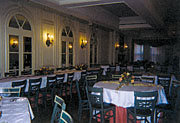
The project management firm responsible for this project was Sebesta Blomberg & McKew, Inc. (SB&M, Topsfield, MA). As the project proceeded into Phase 3 (implementation), the SB&M partnership extended to the trade contractors who proved critical to the program success of this charming, 19th century building.

Implementation – Phase 3
It was time to begin laying the groundwork for implementing the construction strategy. The first step included careful selection of the construction project team and the purchase of major equipment. Whenever a project presents itself with a stringent timeline such as this one, it is imperative to quickly identify any equipment that might be considered a “long-lead” item and to partner with others to round out a team that is creative and quick at problem solving. This is where relationship building is critical. To be successful in a fast-track D-B-F management process, a team leader must have synergy with project partners, and all must be able to work in unison to achieve the overall project objective on time and in budget.Assembling the team was an added challenge given the expeditious onset of the construction schedule. By calling upon relationships which had proven successful in the past, SB&M quickly assembled the rest of the team. The design team was comprised of mechanical, electrical, and plumbing (MEP) design engineering; structural engineering; and acoustical design engineering, as well as architectural design. SB&M took the lead with the dual role of MEP engineer and also the client’s representative, though this client was very active throughout the process as well.
The trades included contractors to cover all of the elements: Digiorgio & Messina Construction Company (Middleton, MA) for general construction; Classic Plumbing & Heating (Waltham, MA) for plumbing; Grinnell Mechanical (Burlington, MA) for hvac; and Tocco Building Systems (Billerica, MA) for electrical. O’Hara & Company, Ltd. (Ashland, MA) performed brownstone repair and restoration, and architectural design support was through Rockport Design (Rockport, MA).
A key to making the program management process (PMP) successful is incorporating the expertise of trade contractors early in the design process. Integrating their experience and knowledge into the process proved to be invaluable in arriving at solutions quickly for the Chilton Club. Given the inadequate, antiquated record documents on hand, the team tried to further determine the condition of the existing systems with limited exploratory work to locate distribution systems during May and mid-June while the club still functioned. During this time, the general contractor (together with the other team members) began to carefully determine those select areas that would be exposed for access to the various distribution systems. It was necessary to employ the precision of a surgeon in order to preserve the architectural and historical integrity of the facility. Full project implementation began in mid-June, during which time the facility completely ceased operations and all furnishings were removed and stored off-site.
As with any building of this age, complications arose and needed to be resolved swiftly. The club manager’s daily participation was integral to this success, providing client decisions quickly. Conducting weekly “brainstorming” meetings with the project team maintained efficiency; the team considered, discussed, and resolved many issues on site. While all team members recognized the need for documentation that would define the scope of work and maintain project costs, it was through working with these prequalified contractors that the field-coordinated drawings were developed that would evolve into final record drawings.
At first glance, mechanical space within the building was at a premium, with virtually no equipment space available in the basement areas. Preliminary designs allowed for the layout of an air-cooled chiller and makeup air unit located on the roof. The requirements of the City of Boston Architectural Commission were stringent, however, in that any mechanical equipment had to be shielded from the view of passersby and abutters.
These criteria, compounded by an additional sound ordinance of 50 dB at night, made this first design economically impractical to achieve within the project budget or timeline. The club routinely hosts functions during these evening hours, so the ordinance was a factor. The team now had to consider alternative locations for the new mechanical equipment within the building. This was no easy task since these buildings, constructed in the 1800s, were not built to accommodate central chiller equipment.
The New Systems
After long deliberation and extensive testing under the guidance of a structural engineer, it was agreed that an existing abandoned elevator penthouse, with minimal modifications, could provide the new home for the 60-ton cooling tower. Further, after obtaining agreement from the client to forfeit some existing storage space in the basement area and a lengthy search for the appropriate cooling equipment to serve the design criteria, it was decided that a compact, 60-ton multistack chiller would be a cost-effective and energy-efficient solution.The existing steam heating system would be replaced by two 785-MBtuh high-efficiency Viessmann hot water boilers for heating and domestic hot water service.
Hot water heating would be distributed throughout the building via individual two-pipe fancoil units to replace the existing steam radiators. Equipment selection here was also challenging, as the existing radiators had all been meticulously enclosed within custom-built cabinetry to complement the décor, and any new units needed to be able to fit within these same spaces. Minimal wall cavity spaces and budget parameters were also considered in weighing the value between a two-pipe and a four-pipe system, with neither of these parameters allowing for the installation of a four-pipe system.
The club would now have a new two-pipe fancoil system to provide the facility with individual room control during the heating and air conditioning seasons. In addition, outdoor air ventilation would be greatly improved via a new makeup air unit for the kitchen and another unit for the central core of the facility. The ventilation scope of work would be completed with the addition of eight-exhaust systems to meet current building codes.
The automatic controls furnished with each piece of equipment were state-of-the-art direct digital controls (ddc). The new ddc controls – furnished with the chiller, boilers, central ahu’s, and each fancoil – will not only improve system performance and space comfort, this new technology will meet and exceed the Massachusetts State Energy Code amendment that takes effect this year.
Early in the construction, another programming decision was made by the client to incorporate a 20-ft by 120-ft architectural soffit to one of the main area ceilings (Figures 1A, 1B). This meant that the mechanical distribution for this area needed to be redesigned. Work also had to begin in this area to remove an existing concealed spline ceiling and to restore the original gilded plaster moldings that had been covered years earlier. Although not part of the original scope of work, the team rolled in this added challenge to the program without compromising the targeted completion date.
In addition to the normal structural incertitude presented by a building of this age, asbestos material was also discovered within the walls and crawl spaces below the buildings. Although the client had presented a report certifying that an asbestos abatement had been previously performed, the work that was now being done in this project was intrusive to those areas beyond where the previous abatement was required. As this material is hazardous and life-threatening, work in these areas stopped until all material was safely removed.
The Good News
After extensive testing and redesign, an acceptable plan of action was finally achieved that met the stringent sight and acoustical conditions set forth by the city ordinances for this district, and the commission issued a certificate of appropriateness on June 17.To minimize the replacement cost of the existing plumbing distribution, nondestructive tests confirmed the integrity of the existing cast iron waste distribution system, while the brass water piping was removed. Further recommendations by the plumbing contractor were made to implement a number of water conservation measures, which would assist in the reduction of annual operating costs. Those measures included reduced-flow showerheads and low-flow toilets.
By calling upon the resourcefulness of the electrical contractor, a more prudent route was developed for the electrical distribution, which assisted in reducing the original scope and budget allowing for these dollars to be spent on other measures (e.g., new energy- efficient light fixtures for each bathroom). And, finally, by replacing the existing steam boiler with a new, high-efficiency hot water boiler, this client was eligible for a rebate from the Boston Gas Company that would be applied to the installation costs.
The Communication Legacy
Staying on top of the process with consistent communication, photographs, and careful documentation provided the client with a complete project history from beginning to end. This process also provided illustrated justification for those who were not intimately involved in the day-to-day construction process but had a vested financial interest in the project’s success.In addition to daily communication and development of record drawings as the job progressed, SB&M established a project website to share progress and action items with those involved without requiring their attendance. The client was also left with a complete computerized maintenance management software (CMMS) workorder system for continued maintenance (Phase 4) for the new equipment and systems, which assists in the ongoing development of operations expenditures.
The integrity of this facility was now in place to continue forward into the next millennium, during which, this organization will celebrate it’s centennial anniversary.
In closing, another element important to a successful partnership is celebrating success. With the collaboration of this client, a formal dinner including the contractors and their spouses was held at the facility. The ladies who were members of the club’s building and maintenance committee also attended to personally thank all those involved. The prevailing comment that evening was that “It doesn’t look as though anything had been done.”
In this case, that was the ideal compliment. The members’ “home” had been restored to resemble its original grandeur, and by utilizing the program management process and today’s technology, a part of history was preserved.

